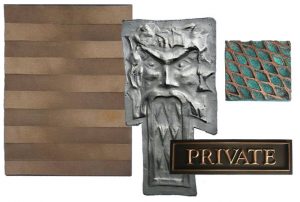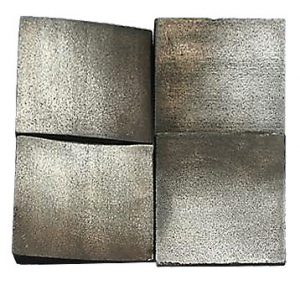 Bauer Fabrication & Art Metal employs a variety of finishes on the materials with which we work. These finishes can be classified as either opaque, such as paint applied to a carbon steel substrate, or translucent, such as patinas and clear coats that are applied to bronze, copper, zinc and carbon steel.
Bauer Fabrication & Art Metal employs a variety of finishes on the materials with which we work. These finishes can be classified as either opaque, such as paint applied to a carbon steel substrate, or translucent, such as patinas and clear coats that are applied to bronze, copper, zinc and carbon steel.
The opaque finishes are the most easily understood and can be readily specified by manufacturers’ catalog numbers and matched to color chip samples.
It is the translucent finishes and their characteristics that we seek to define and quantify for the mutual understanding of our customers and our craftsmen. The subtleties of translucent finishes defy easy description as they are dependent on a variety of variables. Most translucent finishes serve to control the aging or oxidization process of the base material. This is achieved by cleaning and abrading the material, exposing it to various chemical solutions, and then stabilizing the resultant effect with rinses and topcoats.
All these operations are done by skilled hand and trained eye. It is our stated intention to deliver a finish of excellent and reasonably uniform quality.
WHAT TO EXPECT WITH OUR TRANSLUCENT FINISHES ON METAL:
- Our understanding of the desired appearance of a particular finish will be defined by submission of samples for approval. It must be realized that what is seen on a small sample can appear different on a larger piece. What is uniform on a small sample may not be entirely uniform on a more expansive area. Monolithic totally uniform finishes are virtually impossible when applied by hand on larger surfaces. This can be especially apparent on two pieces finished identically, sometimes cut from the same sheet, when viewed next to each other.
- Furthermore, spot treatment to remove blemishes of an isolated area on a part, such as pits and cold shuts, will appear as a variation of texture and color in how it reflects light. We attempt to minimize these differences and isolate their impact, but they define what a hand applied finish on metal is. Color and shade variations can and will occur and are within the acceptable limits of a properly executed job. In fact, these differences are considered as a value and not as a defect.
- Many of our products are made from sheet goods and bar stock that require welding. We strive to make welds disappear when possible or at a minimum, make their appearance acceptable. However, the intense heat required for welding will transform the chemical makeup of the material and therefore lend to color and shade variations that are inherently unavoidable. A weld will often appear darker than the surrounding area.
- It must be noted that over time, since these finishes are extremely thin, they will be abraded by cleaning and hand and foot traffic. Direct and partial exposure of a finished piece will modify its original color and appearance. Normal cleaning must be done with non-abrasive products and occasional application of oil or quality furniture wax depending on circumstances. The wear or “lightening” of the finish, particularly on bronze and copper, is to be expected and is considered a desirable attribute of the patina as it ages.

